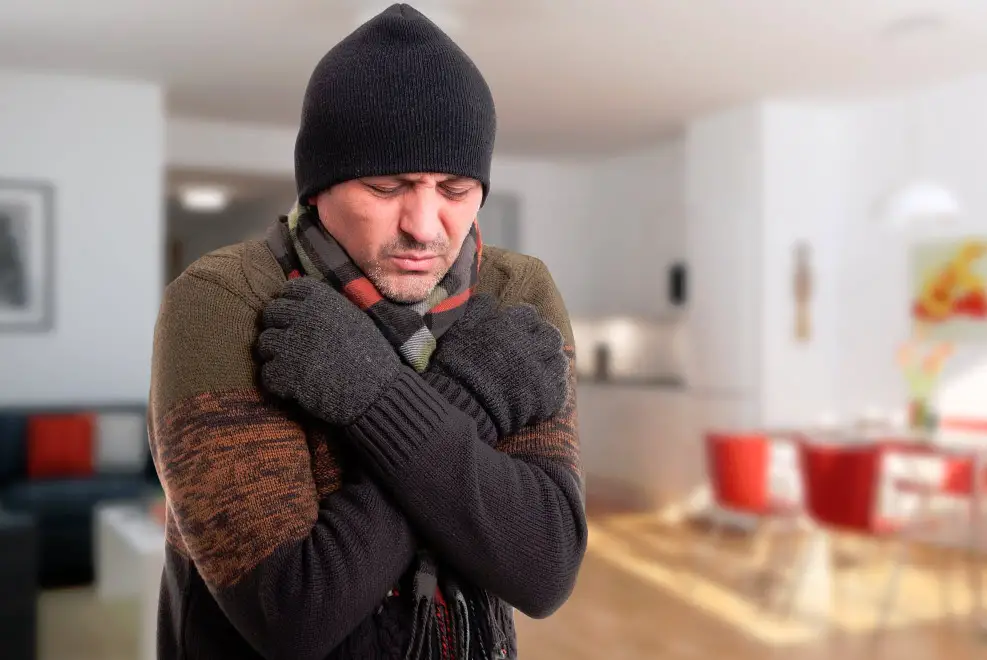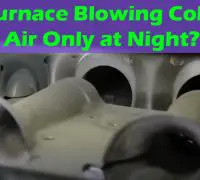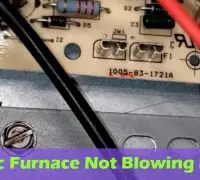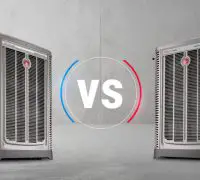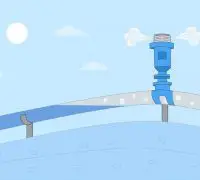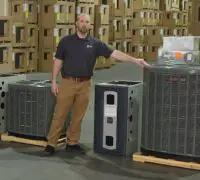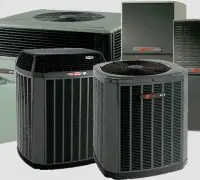Should you use an electric furnace that starts giving cold air suddenly, several issues could make the cause. Most homeowners would choose to call the HVAC technician right from the start, whereas DIY customers with plenty of experience and skills may want to tackle the problem independently.
Page Table of Contents
- Why does the electric furnace blow cold air?
- Troubleshooting an electric furnace blowing cold air- the details
- The thermostat is set on ac or fan.
- The furnace only needs a couple of minutes to warm up
- The thermostat is faulty
- The filter or the coils are dirty
- The heat sensor is faulty
- The contactor is, and the coils aren’t energized
- One or several coils are burned out
- The circuit control for the heating coils has tripped, or it’s off
- Some ducts are leaking
Why does the electric furnace blow cold air?
Several issues on your electric furnace could make it blow cold instead of hot air. Here’s the concise list of possible causes. Check if before going further with the investigations:
- The thermostat is set to fan or AC.
- The contactor is damaged (the coils aren’t energized anymore)
- The thermostat is faulty. It could not request for heat or give the wrong request.
- The filter very dirty
- Some ducts could be leaking (especially the non-insulated ducts)
- The circuit controlling the heating coils has tripped.
- The heat sensor isn’t running.
- The heater needs more time to heat. Just wait for a couple of minutes.
Troubleshooting an electric furnace blowing cold air- the details
Let’s go over the possible causes for your electric furnace, not blowing hot air, and the repairs you can try until the professionals arrive (if they arrive).
The thermostat is set on ac or fan.
The electric furnace’s thermostat comes with several settings, fan and cold (typically refers to ac/air conditioning) included. Sometimes, you’ve set the thermostat to fan/cool or any other setting except heat.
The fix?
You have to check the thermostat to see if it’s on the wrong setting. If so, you have to choose heat to have hot air inside the house.
The furnace only needs a couple of minutes to warm up
Electric coils are supposed to heat very fast. However, when the furnace blower begins to operate, it will push unheated air out of the ducts before the warm air reaches the grates. When you have a large household, and you’re far from the furnace, it will take several minutes until the hot air reaches the grate you’re at.
The fix?
Be patient and wait a couple of minutes to see if the air is warming or not. If it still doesn’t warm up, you may have to check the other possible causes.
The thermostat is faulty
Even if there’s nothing wrong with the furnace, the thermostat could be defective. A faulty thermostat will make the fan run without the coils being energized, so unable to generate heat.
The fix?
If you’re sure that a faulty thermostat is causing the problem, you have to replace the thermostat. But it’s not a bad idea to contact the professionals first, to be positively sure.
Some furnaces take universal thermostats, whereas others only work with a specific model. Make sure you choose the right model.
The filter or the coils are dirty
When the furnace’s filter is dirty, your furnace may still generate hot air, even if you feel that it’s cold air. However, a dirty filter will block airflow, so the heated air won’t manage to get out, or you won’t feel it to be as hot.
Should the heating coils be dirty, they will also make the furnace not heat efficient.
The fix?
You will have to take a good look at the furnace filter and see if it’s something wrong with it. If you haven’t replaced the filter in a while and it’s dirty, don’t hesitate to replace it with a new one.
Some filters are permanent and cleanable, so you will have to follow the manual’s instructions for effective cleaning.
Cleaning the filter isn’t very tricky. Open the cabinet and remove the door. Try to identify the coils; some need unbolting before sliding them out. You may use a shop vacuum hose for carefully vacuuming the coils. If possible, try to get the hose also into the cabinet to remove all debris and dust. Maybe that’s the problem causing the furnace not to give hot air.
The heat sensor is faulty
The electric furnace comes with a heat sensor that ensures that the furnace is generating heat. If the thermostat has reached the desired temperature, it means that the furnace produced enough hot air so that the sensor will turn off the blower fan. But if this sensor is damaged, it will not inform the blower that heat is no longer needed. The furnace will keep on running but will not generate hot air and will blow cold air.
The fix?
Take a look at the temperature setting on the thermostat and the temperature inside the house. Digital thermostats should display both values. When the thermostat’s setpoint is 74f degrees and the thermostat reads 74f or above, and the blower is still operating, the faulty sensor could be the cause.
Even if replacing a faulty sensor isn’t very complicated, it’s better to call the HVAC technician to check and repair the sensor.
The contactor is, and the coils aren’t energized
The contactor is a tough relay that is supposed to turn on the heating elements of the furnace. Sometimes, it’s possible that the contacts become pitted and don’t make contact anymore, causing the issue. You may reseat the connections by merely turning on and off the furnace. However, there’s also the category of furnaces that need replacement when they don’t work anymore.
When you have an electric furnace that doesn’t blow hot air, and you’ve tried anything else, the contractor may be the culprit.
The fix?
You will need to replace the contactor. The electrical relay is between $30 to $100, which is cheaper than the whole furnace.
Should you have the skills and experience, you may give it a try and replace the contactor on your own.
You will have to remove the faulty contactor after loosening the screws that keep it in place. Continue with disconnecting the wiring, and mount the new contactor. Make sure that you have the correct contactor with the equal volts and amps as the now faulty contactor. You will find all the information you need right on the old contactor.
It’s not a bad idea to take a picture of the contactor’s wiring, so you have some visual hints before replacing it with the new contactor.
One or several coils are burned out
Electric furnaces (and heat pump air handlers) come with electric resistance heating coils. It’s perfectly normal for electric coils to wear out after some time or get blown by a power surge. Once the coil is out, though, the furnace’s blower may still operate, but it will give cold air.
The fix?
You have to replace the coil for solving the problem. If the electric furnace is old, you should replace all coils as it’s only a matter of time until all the other coils will wear out.
Replacing electric coils on a furnace isn’t complicated, especially when you have the skills and the tools. Always take the safety measures you need when working with electricity. Needless to say, you should ensure that the circuit to the furnace is turned off at the electric panel. You can never be too safe when working with electricity, so you should lock the box as well so that nobody turns it on accidentally.
The circuit control for the heating coils has tripped, or it’s off
You will only have to look at the electric panel to see if that’s why the cold air is coming from the furnace. Try to identify the circuit controlling the electric furnace heating elements. It has been labeled, so it’s not very difficult to find it.
The fix?
If you cannot see the label, you should search for a circuit in the off position or “in-between” (it’s tripped). You need to turn it back to on position and check if the furnace generates hot air or not.
Should the circuit continue to trip every time you flip it back on, something else is wrong with the electric furnace. Some short in the wiring or a faulty element could cause the tripping.
Some ducts are leaking
Your furnace may run perfectly fine and generate hot air without you even knowing it. Somehow, hot air leaks into the basement, attic, or anywhere else but inside the house where you need it.
Leaking ducts (especially non-insulated) are serious problems, especially since it only gets worse with time. Also, they’re not apparent as you may quickly think that it’s something wrong with your furnace when it gives cold air; and not to think of leaking ducts for a second. Sometimes, even a connection or a joint in the ductwork becomes loose, so you no longer have hot air coming inside the house.
When the blower is operating, but you barely notice any air coming out of grates, some broken ductwork is a primary cause for the electric furnace’s poor performance.
The fix?
Make time and go in the attic/basement, pretty much everywhere you have ducts in the house. Do you notice any of the ducts becoming disconnected? Do you see any gaps in them?
You can tape the ducts with some mastic tape or rigid duct tape if you like DIY work. You should call someone to help you with better results.
The HVAC technician will also be able to fix, seal, and adequately insulate ductwork. Rarely, the ducts will require complete replacement, which is a significant expense. It’s not a bad idea to check the ducts every year or every time you’re servicing the electric furnace.
Keep in mind that all exposed ductwork requires proper insulation for the best performance. Always seal and insulate exposed ductwork, no matter if your furnace gives cold air or not.
If none of these fixes solved the furnace’s problem, you would have to call the professionals for further investigations.
